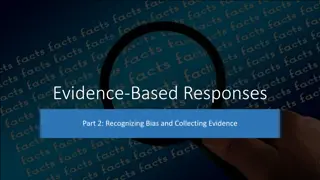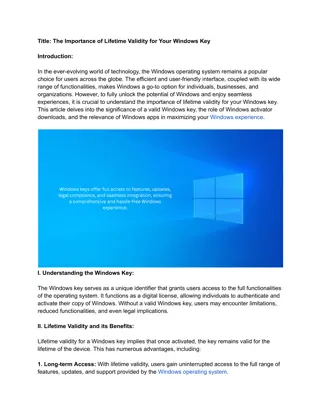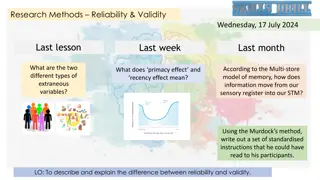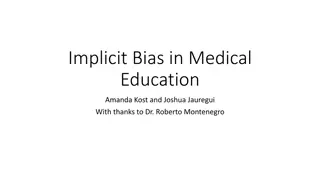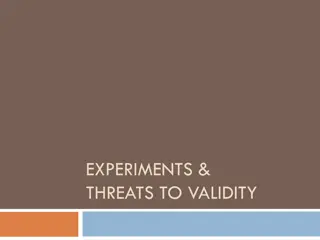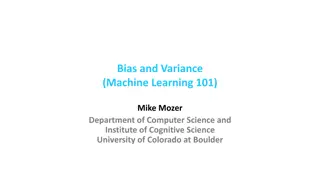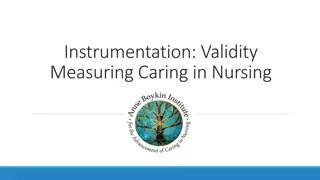Understanding Bias and Validity in Statistical Analysis
Statistical analysis involves considerations of chance, bias, confounding, causation, sample size, and power to ensure valid results. Understanding the impact of these factors is crucial for accurate interpretation of study outcomes and decision-making processes.
Download Presentation

Please find below an Image/Link to download the presentation.
The content on the website is provided AS IS for your information and personal use only. It may not be sold, licensed, or shared on other websites without obtaining consent from the author. Download presentation by click this link. If you encounter any issues during the download, it is possible that the publisher has removed the file from their server.
E N D
Presentation Transcript
Understanding Lack of Validity: Bias Understanding Lack of Validity: Bias
Chance (random error) statistics are used to reduce it by appropriate design of the study statistics are used to estimate the probability that the observed results are due to chance Bias (Systematic error) must be considered in the design of the study Confounding can be dealt with during both the design and the analysis of the study Causation Chance (random error) Bias (Systematic error) Confounding Causation
During design of study Sample size Power During analysis (Statistical measures of chance) Test of statistical significance (P value) Confidence intervals During design of study During analysis (Statistical measures of chance)
Actual Truth of H Actual Truth of H0 0 Decision Decision H H0 0 is true is true H H0 0 is false is false Do not reject H0 Correct Decision Type II Error Type II Error Reject H0 Type I Error Type I Error Correct Decision
the probability the observed results occurred by chance statistically non-significant results are not necessarily attributable to chance due to small sample size
Power = 1 type II error Power = 1
0.00001 Clinical Importance VS Statistical Significance
20 out of 100 participants: 20% 200 out of 1000 participants: 20% 2000 out of 10000 participants: 20% What is the difference?
Definition: interest constructed so that this range has a specified probability of including the true value of the variable for the population Characteristics: a measure of the precision (stability) of an observed effect the range within which the true magnitude of effect lies with a particular degree of certainty 95% C.I. means that true estimate of effect (mean, risk, rate) lies within 2 standard errors of the population mean 95 times out of 100 Confidence intervals get smaller (i.e. more precise or more certain) if the underlying data have less variation/scatter Confidence intervals get smaller if there are more people in your sample Definition: A range of values for a variable of Characteristics:
20 out of 100 participants: 20% 95% CI: 12 to 28 80 out of 400 participants: 20% 95% CI: 16 to 24 2000 out of 10000 participants: 20% 95% CI: 19.2 to 20.8
Chance (random error) statistics are used to reduce it by appropriate design of the study statistics are used to estimate the probability that the observed results are due to chance Bias (Systematic error) must be considered in the design of the study Confounding can be dealt with during both the design and the analysis of the study Causation Chance (random error) Bias (Systematic error) Confounding Causation
Any systematic error that results in an incorrect estimate of the association between risk factors and outcome A systematic error in the design or conduct of a study. The definition of bias relates to the process that is, the design and procedures and not the results of any particular study.
Systematic error results from flaws in either the (1) method of selection of study participants, or (2) in the procedures for gathering relevant exposure and/or disease information Hence - the observed study results will tend to be different from the true results
Study design, Data collection, Analysis Interpretation of results
A faulty study design is considered to be biased (or invalid) because it will produce an erroneous result on average A biased study can produce a result close to the truth when combined with sampling error Conversely, an unbiased study can produce results that are substantially different from the truth because of random sampling variability.
Bias is said to exist when, on average, the results of a hypothetically infinite number of studies (related to a specific association and reference population) differ from the true result
ensuring that the study designincluding the procedures for selection of the study sample is appropriate for addressing the study hypotheses. establishing and carefully monitoring procedures of data collection that are valid and reliable. using appropriate analytic procedures.
Selection bias identification of individual subjects for inclusion in study on the basis of either exposure or disease status depends in some way on the other axis of interest Iinformation bias results from systematic differences in the way data on exposure or outcome are obtained from the various study groups
is present when individuals have different probabilities of being included in the study sample according to relevant study characteristics-namely, the exposure and the outcome of interest.
results from a systematic tendency for individuals selected for inclusion in the study to be erroneously placed in different exposure/outcome categories, thus leading to misclassification.
Selection bias occurs when a systematic error in the ascertainment of study subjects (cases or controls in case-control studies, or exposed or unexposed subjects in cohort studies) results in a tendency toward distorting the measure expressing the association between exposure and outcome. (Berksonian bias)
Because differential bias of the type exemplified in Table 4-3 distorts the nature or magnitude of an association, investigators often attempt to "equalize" bias between the groups under comparison. In retrospective studies, for example, attempts are often made to obtain samples of cases and controls undergoing the same selection processes.
Healthy worker effect: In a cohort study, because study participants (exposed or unexposed) are selected before the disease actually occurs, differential selection according to disease status is less likely to occur. Nevertheless, selection bias may occur at the outset of a cohort study when, for example, a group of persons exposed to an occupational hazard is compared with a sample of the general population. Differential losses to follow-up
In case-control studies, Choose controls from the same study-base as cases. In cohort studies, the rate of loss to follow- up indicates the potential for selection bias. Comparison of the characteristics of those lost to follow-up with those persons remaining under follow-up, may indicate the potential consequences of any selection bias.
Information bias in epidemiologic studies results from either imperfect definitions of study variables or flawed data collection procedures. These errors may result in misclassification of exposure and/or outcome status for a significant proportion of study participants. A classic example is: recall bias, in which the ability to recall past exposure is dependent on case or control status. Cases may be more likely than controls to overstate past exposure
Misclassification of EXPOSURE REFERENCE POPULATION Diseased + - The direction of the association is a function of which cell(s) are subjected to a higher or lower probability + Exposed - Cases Control Eg...unexposed cases in this example tend to mistakenly report past exposure to a greater extent than do controls STUDY SAMPLE
Misclassification of OUTCOME REFERENCE POPULATION Diseased + - + Exposed - Cases Control STUDY SAMPLE Eg cases in this are mistakenly classified as controls due to low sensitivity on a screening test
Exposure Identification Bias Recall bias Interviewer bias Outcome Identification Bias Observer bias Respondent bias
Most cited: inaccurate recall of past exposure (may be due to temporality, social desirability or diagnosis). If recall differs between cases and controls, misclassification is differential; If the error is of similar magnitude, then it is said to be non-differential
Verification of exposure information from participants by review of pre-existing records. Selection of diseased controls and compensating this bias. Objective markers of exposure or susceptibility (for example- genetic markers). Nested case-control studies allow evaluation of exposures prior to case status. 1. 2. 3. 4.
May occur when interviewers are not blinded to disease status. They may probe more Interviewers may be biased toward the study hypothesis (or have other biases). They may ignore protocols
When data collection in a case-control study is not masked with regard to the disease status of study participants, observer bias in ascertaining exposure, such as interviewer bias, may occur. Interviewer bias may be a consequence of trying to "clarify" questions when such clarifications are not part of the study protocol, failing to follow the protocol-determined probing, or skipping rules of questionnaires.
Reliability and validity substudies in samples with quick feedback to interviewers who do not follow the protocol or who have encountered problems. validity studies using independent sources (e.g., medical charts) can be conducted to assess accuracy of data collection by interviewers. Masking of interviewers with regard to case- control status of study participants. 1. 2. 3.
may be due to an imperfect definition of the outcome or to errors at the data collection stage. Two main examples: Observer bias Respondent bias
In a Cohort study: decision to classify outcome may be affected by knowledge of exposure status. Especially soft outcomes such as migraine, or psychiatric symptoms Eg: assignment of diagnosis of hypertensive end-stage renal disease (ESRD). Nephrologists sent case histories were twice as likely to diagnose black patients with ESRD than white patients .
Masking observers in charge of deciding whether the outcome is present by exposure status. stratifying on certainty of diagnosis. Multiple observers
Synonym of recall bias in cohort studies. outcome ascertainment bias may occur during follow-up of a cohort when information on the outcome is obtained by participant response: for example, when collecting information on events for which it is difficult to obtain objective confirmation, such as episodes of migraine headaches.
In a Cohort study: respondents may respond with little consistency to un- standardized questions or to subjective questions. Eg. Questions about depression may be very subjective. A solution is to use a standardized instrument.



